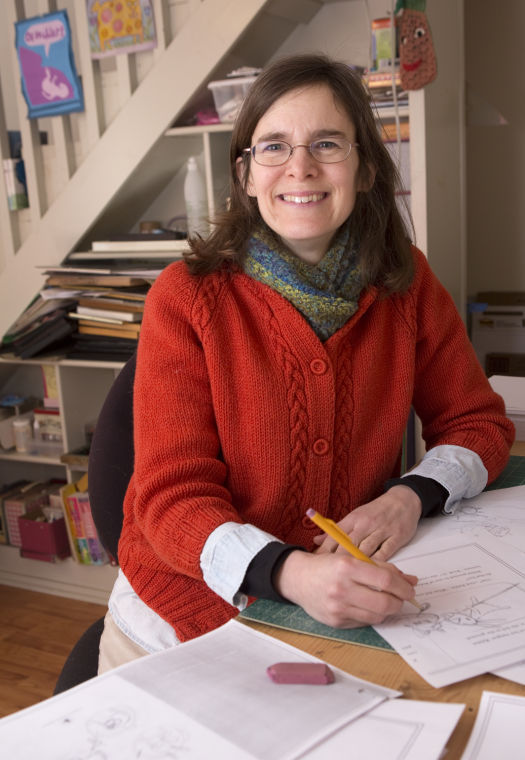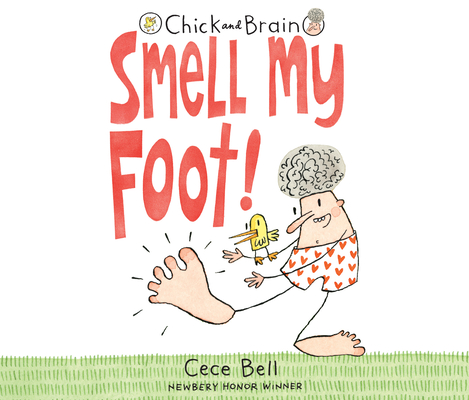Week 4 - Author Study of Cece Bell
Cece Bell became deaf after falling ill at the age of 4. She grew up mostly in the hearing world, but states that she is very interested in Deaf culture. As a child, Cece loved school, but felt like struggled to fit in with the other kids. She eventually went to college to become a writer, then decided to switch to be an art major so she could learn to illustrate. Her now husband was also an art major. Cece Bell is both an author and illustrator.
Cece creates her own stories and sometimes collaborates with others. Her stories tend to be focused on issues of friendship, such as jealously, miscommunications, understanding, caring, and sharing. She writes for a range of elementary school ages. She has created picture books for young children and graphic novels for older children, though she says that picture books and graphic novels may as well be the same thing.
The start to her process for creating children’s literature is to write great ideas on paper, which she then puts into a drawer. When she feels like writing, but isn’t sure what to write about, she chooses 2-3 ideas from this drawer and combines them to create fun, silly content. She writes the story, first. Then, she says she edits away as much of the wording as she can, so that it becomes very simple and meaningful. She then adds illustrations, which she continues to add to until they have a major role in the story.
For more information on Cece Bell, check out the links below:
Blog - https://cecebell.wordpress.com
Twitter - https://twitter.com/cecebellbooks?lang=en
Instagram - https://www.instagram.com/cecebellbooks/?hl=en
Book 1: Rabbit & Robot and Ribbit Genre: Fantasy
Book 2: Chick and Brain: Smell My Foot Genre: Fantasy
Reading: Literature
CCSS.ELA-LITERACY.RL.1.3
Describe characters, settings, and major events in a story, using key details.
CCSS.ELA-LITERACY.RL.1.7
Use illustrations and details in a story to describe its characters, setting, or events.
CCSS.ELA-LITERACY.RL.1.9
Compare and contrast the adventures and experiences of characters in stories.
Writing
CCSS.ELA-LITERACY.W.1.1
Write opinion pieces in which they introduce the topic or name the book they are writing about, state an opinion, supply a reason for the opinion, and provide some sense of closure.
CCSS.ELA-LITERACY.W.1.5
With guidance and support from adults, focus on a topic, respond to questions and suggestions from peers, and add details to strengthen writing as needed.
- After reading each book chosen for this author study students will be able to identify two main characters, the setting, and two major events with 80% accuracy.
- After reading each book chosen for this author study students will be able to use illustrations and details from the stories to describe, compare, and contrast the characters, settings, and events with 80% accuracy.
Reading Assessment:
For part I of this assessment, students will be given a simple graphic organizer for each story which asks them to recall two main characters, the setting, and two major events. Instructions will be written clearly and given orally. The graphic organizers will be graded for accuracy.
The students will then be given the books to use as reference for part II, where they will use a Venn diagram to describe, compare, and contrast the characters, settings, and events from the two stories. The students may analyze illustrations and details from the books to complete this assignment. Instructions will again be written clearly and given orally. The Venn diagrams will be graded for accuracy, corrected after grading, and used to provide information for the writing assessment.
Writing Objectives:
- After reading each book chosen for this author study students will analyze the writer’s purpose or theme in a paragraph with an introduction, supportive reasoning, and a closing with a score of at least 80%.
- After writing their essays from objective one, students will edit their writing with the guidance and suggestions from their teacher and their peers so that their final drafts demonstrate improvement from the original drafts.
Writing Assessment:
Students will analyze a common purpose or theme of the two books from the author study. They will write a paragraph with an introduction, three supporting sentences, and a closing. This draft will be scored, but only for corrective purposes. Suggestions for improvement will be noted and returned to the student. Students will then pair up to perform peer editing. Once students receive their own papers back, they will use suggestions from the teacher and their peers to correct and strengthen their writing in a new, final draft. At this point, the papers will be graded based on a combination of accuracy and the student’s implementation of suggestions for improvement. Clear rubrics will be passed out with expectations for the final draft.
Overall Activity for Author Study:
Students will write two to three ideas on slips of paper, then add them to a collective pile. Students will take turns drawing ideas from the pile until each student has chosen two. Students will then combine these two ideas to write a short story. After writing their stories, they will trade off with a partner who will suggest edits to the story. Once the writer makes any necessary edits, they will create three illustrations to accompany their story. Students will gather into small groups of four to five students and take turns reading their stories to one another. After completing this activity, students will discuss this process of writing a story. What went well? What was difficult? Why do you think Cece Bell uses this method for writing, sometimes?
Struggling readers may find humor in the language used in Cece Bell’s stories. The simple, large print is easy to read and follow, while the illustrations improve comprehension. These books will be easy for even struggling readers to enjoy.
Differentiation for Advanced Readers:
Advanced readers will find interesting parallels between the friendships in the books and friendships in Bell’s life, as well as friendships in their own lives. They will be able to laugh at the simple humor while exploring bigger themes and ideas woven into Bell’s literature.
Bell, C. (2020). Chick and brain: Smell my foot! Walker Books Ltd.
Bell, C. (2014). El Deafo. Amulet Books.
Bell, C. (2017). Rabbit & robot and ribbit. Candlewick Press.
English language arts standards. English Language Arts Standards | Common Core State Standards Initiative. (2021). http://www.corestandards.org/ELA-Literacy/.




No comments:
Post a Comment